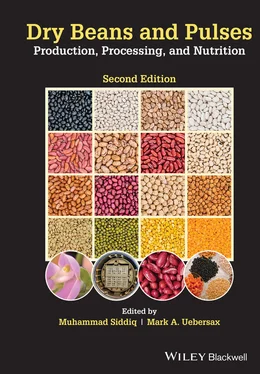Dry Beans and Pulses Production, Processing, and Nutrition
Здесь есть возможность читать онлайн «Dry Beans and Pulses Production, Processing, and Nutrition» — ознакомительный отрывок электронной книги совершенно бесплатно, а после прочтения отрывка купить полную версию. В некоторых случаях можно слушать аудио, скачать через торрент в формате fb2 и присутствует краткое содержание. Жанр: unrecognised, на английском языке. Описание произведения, (предисловие) а так же отзывы посетителей доступны на портале библиотеки ЛибКат.
- Название:Dry Beans and Pulses Production, Processing, and Nutrition
- Автор:
- Жанр:
- Год:неизвестен
- ISBN:нет данных
- Рейтинг книги:5 / 5. Голосов: 1
-
Избранное:Добавить в избранное
- Отзывы:
-
Ваша оценка:
- 100
- 1
- 2
- 3
- 4
- 5
Dry Beans and Pulses Production, Processing, and Nutrition: краткое содержание, описание и аннотация
Предлагаем к чтению аннотацию, описание, краткое содержание или предисловие (зависит от того, что написал сам автор книги «Dry Beans and Pulses Production, Processing, and Nutrition»). Если вы не нашли необходимую информацию о книге — напишите в комментариях, мы постараемся отыскать её.
The second edition of the most complete and authoritative reference on dry beans production, processing, and nutrition available Dry Beans and Pulses: Production, Processing, and Nutrition
Dry Beans and Pulses: Production, Processing, and Nutrition, Second Edition
Dry Beans and Pulses Production, Processing, and Nutrition — читать онлайн ознакомительный отрывок
Ниже представлен текст книги, разбитый по страницам. Система сохранения места последней прочитанной страницы, позволяет с удобством читать онлайн бесплатно книгу «Dry Beans and Pulses Production, Processing, and Nutrition», без необходимости каждый раз заново искать на чём Вы остановились. Поставьте закладку, и сможете в любой момент перейти на страницу, на которой закончили чтение.
Интервал:
Закладка:
While there have been at least seven QTL studies published on the inheritance of iron and zinc, applying these to marker assisted selection has not proved to be worthwhile (Freyre et al. 1998; Blair et al. 2009, 2010, 2011; Cichy et al. 2009, 2014; Blair and Izquierdo 2012). Any one QTL typically only provides the potential for a few ppm increase in iron or zinc, and these small levels would easily be confounded with environmental variation. Levels of Fe and Zn in the seed are influenced by the environment, especially soil fertility levels (Cichy et al. 2009; White and Broadley, 2009; Katuuramu et al. 2021). Genomic selection may hold promise to improve breeding gains. Future work is also likely to be more directed to iron bioavailability, as opposed to iron concentration, to achieve the maximum nutritional benefits to the consumer (Katuuramu et al. 2021).
Niche Markets
Organic dry beans
Organic dry beans are a high‐value specialty crop of multiple market classes, including black, dark red kidney, and white kidney beans. Dry beans are an appealing option for organic farmers, since consumer demand is strong. The price premium for organic dry beans is 1.5–3 times that of conventionally produced beans. Controlling weeds and insect pests effectively without the use of pesticides is a major challenge for organic producers (Frick et al. 2017). Despite these constraints many larger producers continue to produce high‐quality organic beans but at resulting lower yields. In side‐by‐side studies over three years in Michigan, 36 bean varieties grown under organic production systems averaged 18% lower yields than under conventional systems (Heilig and Kelly 2012).
Currently, organic producers use varieties developed for conventional production systems and some of these may not perform as well under organic production systems. Prior dry bean breeding research suggests that breeding under organic systems is more valuable in some market classes than others. Genetic variability for seed yield under organic vs. conventional showed that for black and navy beans the best lines under organic were also the best performers under conventional (Heilig and Kelly 2012). This is likely because of the goals of conventional breeding programs are beneficial for all producers. For example, traits such as disease or insect resistance, overall productivity, and improved plant architecture are valuable for both conventional and organic producers. Heilig and Kelly (2012) found that in the case of kidney beans the best lines under conventional were not necessarily the best under organic. Therefore, selecting kidney lines under organic conditions would be beneficial to improve germplasm for organic production. Breeding for organic production systems is underway in multiple public breeding programs around the US.
Slow darkening (SD) pinto beans
Consumer preference for pinto beans is often dictated by seed color. Most pinto bean cultivars possess a brown mottled color on beige background; however, this pigmentation changes with postharvest aging. The bright beige background darkens with storage and has been used as a means for purchase decisions in traditional markets for discriminating between fresh/new crop (bright color) and old/aged (dark color) beans. Plant breeders were able to isolate this characteristic as a heritable trait (recessive sd gene). This has resulted in the recent release of several SD cultivars ( Vibrant, Radiant, Lumen, Gleam, Palomino, Staybright) that take considerably longer to darken during storage (Rodrigues et al. 2019; Miklas et al. 2020). SD pinto beans produced in controlled field trials exhibited slightly better canning quality than standard pintos. The distinctive color of SD pintos requires strict segregation as a market class to assure lot uniformity.
Heirloom beans
Heirloom beans is another niche opportunity for bean breeders. Demand for heirloom and specialty beans is increasing, and this trend is due in part to direct‐to‐consumer bean sellers such as Rancho Gordo, that have effectively created demand by framing stories around the beans which appeal to consumers (King et al. 2021). Some popular heirloom beans include Jacob’s Cattle, Calypso, Soldier, and Hidatso Red. There is also interest on the part of breeders to improve heirloom beans for agronomic characteristics and disease resistance. Studies of the yield and SNF capacity of heirloom vs conventional showed comparable yields for some heirlooms and reductions for others suggesting they can be incorporated into parents in breeding programs without major yield drag (Swegarden et al. 2016; Wilker et al. 2019). Five improved heirlooms were recently released by UC Davis, including a Rio Zape and Tiger’s Eye. Each was improved by backcrossing with the I gene to add BCMV resistance while maintaining the heirloom seed types (Parker et al. 2021a,b,c,d,e).
GENOMIC RESEARCH AND TRANSGENIC BEANS
Genomic research
The Phaseolus vulgaris genome sequence of the Andean landrace, Chacha Chuga (G19833) was released in 2014 (Schmutz et al. 2014); v2.1 is the most current version available, which has been updated with long read PacBio sequencing. The sequence is available at phytozome.jgi.doe.gov. Since the genome release, there has been a surplus of genomics research on beans. This research has aided in our understanding of genetic mechanisms for various traits, including better understanding pathogen response for anthracnose and common bacterial blight (Vaz Bisneta et al. 2020; Simons et al. 2021), drought stress (Diaz et al. 2020), and domestication related traits (Soltani et al. 2021), to name a few.
Marker platforms have largely moved to SNP based, with the Illumina BARCBean6K_3 SNP BeadChip (Song et al. 2015) and BARCBean12K BeadChip, which includes all SNPs from the BARCBean6K_and additional SNPs among a set of Andean accessions. The large reduction in the cost of DNA sequencing in recent years has made sequencing (whether RNA or DNA) a fairly regular aspect of bean genetics discovery work. Genotype by sequencing is also commonly applied as a SNP marker generating method that can then be used for mapping purposes, for both recombinant inbred line populations and diversity panels (Schröder et al. 2016; Katuuramu et al. 2018). Genome resequencing is also gaining popularity in bean genomics projects to gain understanding of the genetic architecture for traits such as seed yield and stress tolerance (Wu et al. 2020). Kompetitive Allele Specific PCR (KASP TM)‐based SNP marker system has been successfully integrated for marker assisted breeding tool in many labs (Raatz et al. 2019). This technology is easily outsourced to service companies, which makes it a viable option for most breeders, even those without a lab or dedicated DNA‐related equipment. The new frontier in genomics for bean breeding is genomic selection (Keller et al. 2020). Some studies are underway, although it remains to be seen how easily this will be implemented since dry bean breeding efforts occur in at least 10 different market classes, each somewhat isolated from the other, so it may not be possible to achieve the numbers necessary to make genomic prediction worth the investment.
Transgenic beans
Thus far, no commercially available bean varieties developed through genetic modification (GM) or through gene engineering are being marketed in the US. Beans have lagged behind soybeans in the utilization of this technology for a number of reasons (Veltcheva et al. 2005; Song et al. 2020). The major reason was the absence of an incentive to develop a GM bean by private industry as the acreage base is so small compared to soybean. This meant that there was limited investment or financial resources targeted to develop a GM bean, either in the public or private sector. In addition, the smaller acreage planted to dry beans is dispersed over six to eight major market classes in addition to the different horticultural types, so no economic incentive existed to pursue the development of GM bean as any financial returns would be small. Since beans are cropped with soybeans, the private sector did not want herbicide‐resistant volunteer beans appearing in the soybean or corn crop the following season. The additional hurdle was the recalcitrant nature of beans to regeneration and plant transformation.
Читать дальшеИнтервал:
Закладка:
Похожие книги на «Dry Beans and Pulses Production, Processing, and Nutrition»
Представляем Вашему вниманию похожие книги на «Dry Beans and Pulses Production, Processing, and Nutrition» списком для выбора. Мы отобрали схожую по названию и смыслу литературу в надежде предоставить читателям больше вариантов отыскать новые, интересные, ещё непрочитанные произведения.
Обсуждение, отзывы о книге «Dry Beans and Pulses Production, Processing, and Nutrition» и просто собственные мнения читателей. Оставьте ваши комментарии, напишите, что Вы думаете о произведении, его смысле или главных героях. Укажите что конкретно понравилось, а что нет, и почему Вы так считаете.












